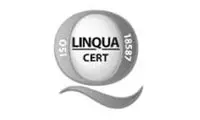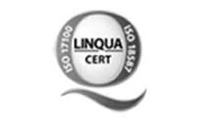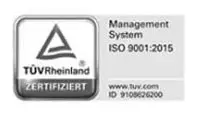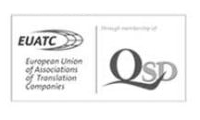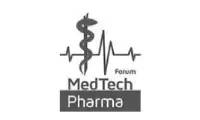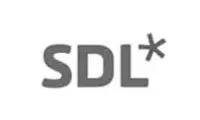Quick, reliable and precise
In the highly regulated industries of pharmaceuticals, biotechnology and medical technology, efficient translation plays a critical role. Language should not be a barrier when it comes to developing new medical or medical technology procedures, communicating between international research teams, registration documents or the secure handling of patient data. Our AI-based machine translation offers an effective, rapid, scalable and reliable solution for your translation requirements.
Precision that makes the difference – you can rely on mpü!
ISO certified –
for your security

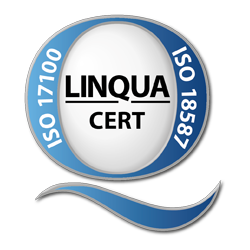
Good to know:
mpü is certified as a language service provider.
These international standards define and specify all phases of the translation process to ensure consistently high quality.
- Translation quality
is ensured and certified at each step according to DIN EN ISO 17100 - Quality management
is certified according to DIN EN ISO 9001:2015 - Post-editing machine translated content
is certified according to DIN EN ISO 18587
That means we provide the results that your exacting documentation requires.
Difference between AI and machine translation
While machine translation has existed for decades, the integration of AI has taken these technologies to a new level. The main difference lies in AI’s ability to understand semantic links and make context-related decisions.
1. Machine translation (MT)
- Works with fixed sets of rules.
- Translates literally, often without considering the context.
- Limited learning capacity without human adaptation.
- The quality depends on the source text.
2. AI-based machine translation (NMT)
- Uses neuronal networks and deep learning.
- Considers context and linguistic nuances.
- Continuously improves through training and user feedback.
2. AI-based machine translation (NMT)
Neuronal networks analyse sentence structures, detect links and adapt linguistic nuances. This results in more natural translations that better take into account the technical context. In sensitive areas such as medicine, medical technology and biotechnology, this difference is critical.
The neuronal network draws conclusions based on the context in the sentence and calculates the most likely possibility for the next word.
Pre-translation with existing translation memories can be done prior to NMT to increase the quality.
Engines (MT systems) can be trained on different topics to use context-based terminology.
Based on the current situation, this translation produces the best results.
3. Trained customer-specific NMT engines
Trained NMT engines are specifically tailored to specialist fields. They learn through their translation memories (TMs) and terminology databases to translate industry-specific terms correctly. The training can be repeated in cycles of 3-6 months to further improve the performance.
Advantages:
Consistency in technical language
Specialist terms and company-specific terminology are used precisely, improving legibility and quality.
Improved quality through continuous training
The more an engine is used and adapted, the better it performs. Progressive learning methods ensure continuous optimisation.
Integration into existing workflows
The technology can easily be integrated into existing systems and processes so work processes are not disrupted.
Generative AI in machine translation engines
4. AI translation with Large Language Models (LLMs)
LLMs are generative AI such as ChatGPT. This system doesn’t really translate, it creates an entirely new text in the target language. The new text is looseley translated and can deviate significantly from the source text. If the AI has not received the right commands, entire sentences and content can also be freely invented.
This type of AI is currently used more for checking and fine tuning translations. Tonality and warmth can be adjusted, or the text adapted to the appropriate target group.
Higher context sensitivity
Generative AI can interpret complex sentence structures and create translations with sensible content. It can also understand the context of the text and include it.
Consideration of cultural subtleties
The technology is able to adapt linguistic and cultural nuances so texts are understandable and appealing in various markets.
Automatic error correction
AI-based engines learn continuously from their mistakes and can make quality improvements themselves.
“Technology meets human expertise for the perfect results!”
Is human post-processing still necessary?
Types of post-editing:
Post-editing ensures that the translation is free of errors, consistent and technically correct.
1. Light post-editing
Minimal intervention to improve comprehensibility. Only serious errors are corrected here, resulting in a functional but not perfect text.
2. Full post-editing
Extensive revision to a professional translation level, optimising the text from a terminology and grammar perspective.
3. Revision by a second technical translator
Ensures linguistic and technical optimisation of the text.
Translation model as needed
Pure machine translation –
quick but no quality check
Our simplest solution based exclusively on machine translation with no human revision. This method:
- Does not take into account specific terminology or style
- Is primarily suitable for recording the initial content of texts, particularly general content with no specific customer requirements
- Can be used to process large quantities of text

Customer-specific machine translation (NMT) –
optimised with your terminology
This variant of machine translation is optimised through customer-specific training but is also done without subsequent manual correction. This option:
- Provides greater accuracy and better quality than an untrained machine
- Needs at least 50,000 sentences as the basis for training to achieve a noticeable improvement
- Ensures a significant increase in quality
- Is ideal for uses in which machine translation without human post-processing is desired
Machine translation (MT) with light post-editing –
basic adjustments for better comprehensibility
With this option, the machine translation is optimised through linguistic correction, but only to a limited extent. Language professionals intervene if the output from the machine is incomprehensible or the original meaning is not correctly reproduced. This method:
- Generates a legible and understandable translation but one that is still not stylistically perfect
- Is ideal for less critical content where fast processing is more important than the highest quality
- Can sometimes lead to literal or somewhat unnatural wording


Machine translation (NMT) + full post-editing –
at the level of a human translation
This high-quality translation method combines the efficiency of a machine with extensive human post-processing. An experienced linguist optimises the machine output so the quality of a professional, human translation is achieved. The solution:
- Provides an end product of the same quality as a fully human translation
- Can be supplemented by proofreading or additional quality assurance steps
- Essentially follows the same process as human translation, with the first processing step done by AI
- Is particularly suitable for structured and technical content
- Can also be used for other types of text if a high quality is needed
What factors affect the quality of MT?
MT quality depends on:
- The quality of the source text: clear, simple sentence structures improve the results significantly and facilitate processing with AI systems. Longer sentences and complex issues across multiple sentences cause problems.
- Language pairs: some languages are better suited to MT than others as they have fewer grammar and syntax-related obstacles. More commonly spoken languages and similar language pairs generally work better.
- Training data: the more high-quality data is used, the better the result. Engines that are trained in a targeted way provide much better results than generic models.
How can the results be optimised?
- File preparation*: Before machine translation, the text is checked for suitability using the criteria listed below.
- Use of specialised, trained engines*: tailored solutions ensure more precise and consistent translations.
- Use of translation memories and terminology databases: consistency is a critical factor when it comes to a high translation quality. Pre-translation with existing databases is a matter of course for us.
- Human check in the form of post-editing: despite all the progress that has been made, humans remain essential to make final corrections.

*File processing and MT engines: an overview
Benefits of machine and
AI-based translation
Efficiency and cost savings
- Reduction in processing time of up to 50%:
Automated translation reduces the time for the initial translation significantly, so content is more quickly available for the market.
- Reduction in translation costs of up to 40%:
Since there is less need for manual adjustments, the costs drop while the efficiency rises.
Scalability and flexibility
- Rapid translation of large quantities of documents: even extensive and complex texts can be translated quickly.
- Support for the most common language combinations: the systems cover a wide range of languages, facilitating international expansion.
Quality assurance
- Combination with post-editing by technical translators: human experts ensure a final correction of the machine-generated content.
- Combination with post-editing and revision by a second technical translator:
The additional revision ensures linguistic and technical optimisation of the text. - Validation through BLEU and TER benchmarks: quality measurements help to continuously check and improve accuracy.
Why is mpü your ideal partner for machine translation?
Machine translation (MT) at mpü combines the latest AI technology with human expertise and is specifically tailored to the requirements of the pharmaceutical, biotechnology and medical technology industry. Our solution offers a precise, reliable and efficient translation of large quantities of text in a short amount of time.
Our benefits at a glance:
- Specialised in life sciences: technical competence for highly sensitive documents in the fields of pharmaceuticals, biotechnology and medical technology.
- AI-based workflows and trainable MT engines: adaptable solutions for optimal translation quality.
- High-quality post-editing by experts: a human check ensures the highest level of precision and quality.
- Rapid translation: automatic processing of large quantities of text in seconds instead of days.
- High accuracy thanks to AI models: constant improvement in the translations through continuous machine learning.
- Adherence to compliance requirements: ISO-certified technologies ensure data protection and security.
- Seamless integration: simple implementation into existing IT systems and workflows.
- Cost-effectiveness: reduced translation costs with a simultaneous rise in productivity.
- Multilingual support: translations in over 3,000 language combinations.

